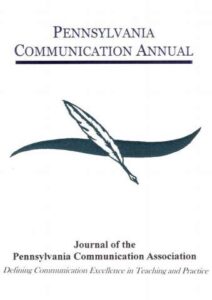
Pennsylvania Communication Annual
Submission Guidelines
The Pennsylvania Communication Annual is dedicated to advancing our undertaking of human communication. Manuscripts should be original and should discuss instructional, theoretical, philosophical, and/or practical aspects of any area of communication. Reviews of recent books and/or video tapes in any area of communication are also considered at the editor’s discretion. While articles authored by Pennsylvanians and articles covering Pennsylvania topics are especially welcome, manuscripts on all topics and from all regions, including international submissions, are invited and will receive full consideration for publication. Your papers should not have any information about your identity.
The Pennsylvania Communication Annual is a refereed journal of the Pennsylvania Communication Association. Manuscripts for the 2025 issue (v.81) are now being received. The overall acceptance rate of the journal is 36 percent, and for 2023 and 2024 issues, the acceptance rates were respectively 38 and 40 percent. Submission should follow the latest APA style sheet. Please format your papers for blind review and remove anything that may give away your identity. Manuscripts should not exceed 8000 words including references, notes, tables and other citations. Also book reviews should not exceed 2000 words. The submission deadline is May 30, 2025. Please submit your articles to The Pennsylvania Communication Annual at https://www.ejmanager.com/my/pca/ website. The Pennsylvania Communication Annual is indexed and archived by the EBSCO Host’s Communication Source database. Please also see our selected online archive. Some important details to follow when submitting your manuscripts:
- If you use footnotes or endnotes: Endnotes only and without formatting, no footnotes.
- No superscript font to indicate an endnote, just regular numbers and we will superscript upon editing.
- Insert tables and illustrations as images only or send separate PDF files of these portions of the documents.
- Formatted hanging indents only on references or no formatting at all; no “return” and “tab” to create the look of a hanging indent.
Editor: Cem Zeytinoglu, Ph.D., Professor of Communication, Monroe Hall 316, East Stroudsburg University of Pennsylvania, East Stroudsburg, PA, 18301-2999. Phone: 570-422-3911. Email: czeytinoglu@esu.edu